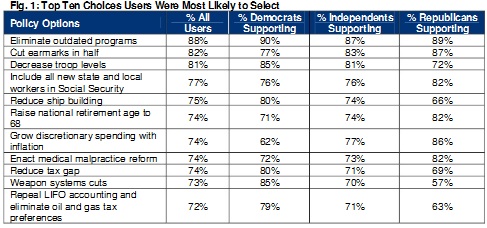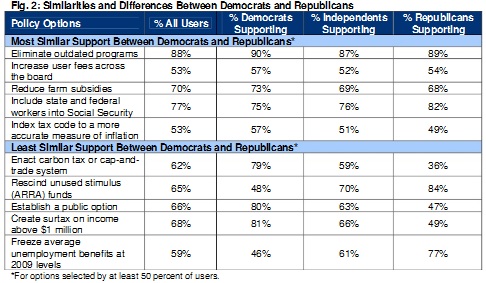CRFB’s Simulator: A Tool for Fixing the Budget
To hear the news coming out of Washington, finding the route to fiscal stability can be pretty hopeless as our leaders all steer in different directions. If only we had a GPS! Well, maybe we do.
Today, we released the results of our online budget simulator. The results indicate that when the scope of the budget problem is evident, people are willing to make the difficult decisions to correct the course we're on. They are showing the way for their leaders.
In the period from October 2010 through January 2012, over 8,000 simulator users voluntarily submitted their results for analysis. Although these results are not scientific, the findings are nonetheless informative for policymakers. Eighty percent of the sample accomplished the goal of stabilizing the debt at 60 percent of GDP by 2018.
The top ten most selected options (see table below) are illustrative. Sure, the most popular choices were to eliminate outdated programs and get rid of earmarks – the lowest hanging fruit that lawmakers have mostly picked already. But they didn’t stop there. Once users saw the paltry savings from these choices (a mere $120 billion through 2018) they moved on and made tougher choices. Three of the top ten top choices involved reducing military spending and two involved Social Security – two areas where policymakers are very entrenched right now.

CRFB’s “Stabilize the Debt” budget simulator offers users a sizeable list of options and shows how each of those choices affects America’s fiscal outlook. The user has a clear goal of stabilizing the public debt in the medium term at 60 percent of the economy, an internationally recognized standard.
This is how budgeting should be done -- setting priorities and calculating trade-offs, with a fiscal goal in mind. This thinking seems absent in the current environment, with the budget process becoming more and more dysfunctional. The lack of action is why we moved the target date back to 2021 in the newer version, 2018 isn't realistic anymore. Hopefully, we will not have to move the goal posts any further.
But constituents seem to get it. The simulator has been used in classrooms, living rooms and offices across the country.
As can be expected, there were choices where users split clearly along party lines, but there were also substantive options that saw remarkable consensus (see table below). Reducing farm subsidies and adding new state and local workers to Social Security – two timely issues – saw a great deal of support across the political spectrum.

As we seek to navigate between a “fiscal cliff” and a mountain of debt, there is a path to sustainability. Americans are pointing the way. Hopefully, politicians will be sensible enough to ask for directions.
Read the summary of results
View the full results
Try the newest simulator yourself